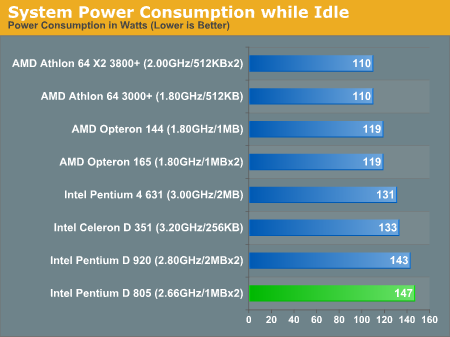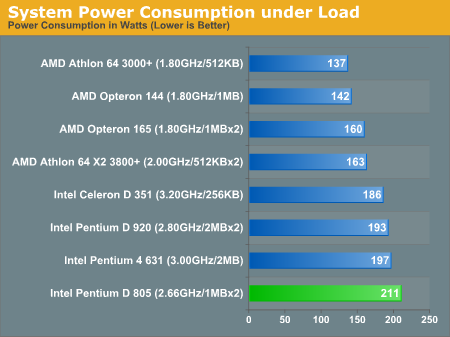Intel Pentium D 805 - Dual Core on a Budget
by Anand Lal Shimpi on April 7, 2006 12:00 AM EST- Posted in
- CPUs
Power Consumption
As always, we measured power consumption of the entire system at the wall outlet. First up is power consumption with the test system at idle. Here AMD's Cool 'n Quiet and Intel's EIST really come into play and do their best to reduce power consumption:

As you can expect, based on the old 90nm Smithfield core, the Pentium D 805 isn't exactly the coolest running chip on the block. In fact, the Athlon 64 3000+ consumes less power under full load than the Pentium D 805 does with both of its cores idling. Note that the higher power consumption on the two Opteron parts is because Cool 'n Quiet would not work with the Opterons on our test platform.

The picture doesn't get any prettier under full load. If you're expecting the Pentium D 805 to be a cool running, quiet chip, you're going to be sorely disappointed. If power consumption matters to you then you're far better off with a Pentium D 900 series or an Athlon 64 X2.
Looking at the long-term prospects, power costs money, so how long will it be before the lower power X2 3800+ reaches the break-even point? If we go with a typical $.10 per kWHr, the X2 3800+ consumes 37W less at idle and 48W less at full load. If that seems like a lot of power initially, it actually only works out to $32-$42 per year, running both systems 24/7. That means you're looking at a minimum of four years to reach equivalence in price+power. What about the 920 versus 805 power costs? The difference there is even less in terms of power use, so even at full load you're looking at $16 per year, or seven years to reach the break-even point.
Of course, you can't just look at power in most instances. The X2 3800+ will offer you faster performance during its lifetime, so it definitely warrants consideration. Lower power, lower heat, lower noise, and higher performance are all nice things to have.
Note: Pentium D 820 numbers were excluded from the power comparison due to technical difficulties with our test platform at the last minute. Based on the data here, you can expect it to consume more power than the Pentium D 805.










51 Comments
View All Comments
Nick5324 - Friday, April 7, 2006 - link
Agree, good stuff! I'm looking forward to the overclocking write up.whitelight - Friday, April 7, 2006 - link
i liked how you included a large variety of cpu's. thanks!lifeblood - Friday, April 7, 2006 - link
Having read all the reviews of EE this and XF that, I was starting to think my poor little +3000 was ready for the garbage heap. After reading this article I was very happy to see my +3000 still does quite well in office productivity and games which is it's primary use. I guess I will keep it around another year before upgrading to an X2.PrinceGaz - Friday, April 7, 2006 - link
Superb article Anand, this is the kind of article I like; a test that includes all of the likely alternative chips that might be considered and where something useful is said under each graph instead of just presenting page after page of graphs with no comments. Okay so I look at the graphs first and make my own mind up, but it's always good to see what someone else thinks in each test to see if I missed something important. I look forward to more articles like this; hopefully the Pentium D 805 overclocking article will also look at overclocking the other chips, not just the 805.The one error I refer to is that although the Celeron D processor is correctly identified as having 256KB L2 cache in pages 2 and 3 of the article, on all of the graphs (page 4 onwards) it says 512KB. Shouldn't take long to fix.
Dfere - Friday, April 7, 2006 - link
I liked the article- not for the graphs. I rad the beginning, some of the set up and the conclusions, and the comments. I am not a tech head! I agree it is nice to get a broad based analysis/market comparison, especially on the "value" segment orbusiness stuff. (CPA here).JarredWalton - Friday, April 7, 2006 - link
Fixed, thanks! (Not as easy to correct as you might suspect... graphs require a bit more effort, but at least it was only one change per graph.)YellowWing - Friday, April 7, 2006 - link
No mention of 64 bit support in the 805, is 64 bit possible?Viditor - Friday, April 7, 2006 - link
Yes...
FSB = 533 MHz
Cache = 2x1MB
Clockspeed = 2.66 GHz
Virtualization = No
Enhanced Speed Step = No
EM64T = Yes
YellowWing - Friday, April 7, 2006 - link
ThanksJackPack - Friday, April 7, 2006 - link
Yes, of course.